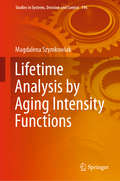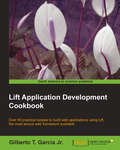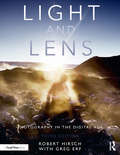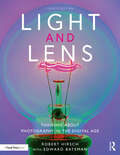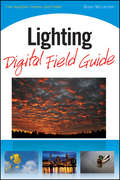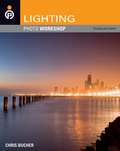- Table View
- List View
Liferay Portal Systems Development
by Jonas X. YuanThis book focuses on teaching by example. Every chapter provides an overview, and then dives right into hands-on examples so you can see and play with the solution in your own environment. This book is for Java developers who don't need any prior experience with Liferay portal. Although Liferay portal makes heavy use of open source frameworks, no prior experience of using these is assumed.
Liferay User Interface Development
by Jonas X. Yuan Xinsheng Chen Frank YuThis is a basic tutorial that teaches you how to use the tools provided by Liferay to create your own applications. It covers a lot of the material that has API references and documentation of the architecture and illustrates its key concepts with examples.If you have basic knowledge of Java Web applications, know the basic operational functionality of Liferay, and have written a servlet or JSP file, you are ready to get the most out of this book. Whether you are a web portal engineer or an experienced Liferay Portal developer, you can benefit from this book. You are not expected to have prior knowledge of Liferay theming.
Lifestyle Brands: A Guide to Aspirational Marketing
by S. Saviolo A. MarazzaWhat do brands like Apple, Diesel, Abercrombie & Fitch and Virgin have in common and what differentiates them from other brands? These brands are able to maintain a relationship with their clients that goes beyond brand loyalty. This gives a complete analysis of Lifestyle Brands, that inspire, guide and motivate beyond product benefits alone.
Lifetime Analysis by Aging Intensity Functions (Studies in Systems, Decision and Control #196)
by Magdalena SzymkowiakThis book addresses a range of aging intensity functions, which make it possible to measure and compare aging trends for lifetime random variables. Moreover, they can be used for the characterization of lifetime distributions, also with bounded support. Stochastic orders based on the aging intensities, and their connections with some other orders, are also discussed. To demonstrate the applicability of aging intensity in reliability practice, the book analyzes both real and generated data. The estimated, properly chosen, aging intensity function is mainly recommended to identify data’s lifetime distribution, and secondly, to estimate some of the parameters of the identified distribution. Both reliability researchers and practitioners will find the book a valuable guide and source of inspiration.
Lift Application Development Cookbook
by Gilberto T. GarciaJr.Lift Application Development Cookbook contains practical recipes on everything you will need to create secure web applications using this amazing framework.The book first teaches you basic topics such as starting a new application and gradually moves on to teach you advanced topics to achieve a certain task. Then, it explains every step in detail so that you can build your knowledge about how things work.This book is for developers who have at least some basic knowledge about Scala and who are looking for a functional, secure, and modern web framework. Prior experience with HTML and JavaScript is assumed.
Light and Lens: Photography in the Digital Age
by Robert HirschLight & Lens: Photography in the Digital Age is a groundbreaking introductory book that clearly and concisely provides the instruction and building blocks necessary to create thought-provoking digitally based photographs. It is an adventurous idea book that features numerous classroom-tested assignments and exercises from leading photographic educators to encourage you to critically explore and make images from the photographers' eye, an aesthetic point of view. Acquire a basic foundation for digital photography. Light and Lens covers the fundamental concepts of image-making; how to use today's digital technology to create compelling images; and how to output and preserve images in the digital world.Explore the history, theory and methods of digital image-making. Light and Lens translates the enduring aesthetics of art photography into the digital realm. You'll view, capture and think about images from a new perspective.Increase your ability to analyze, discuss and write about your own work and the images of others.Learn with exercises and assignments by leading digital educators. Innovative techniques will train your eye to make the strongest visual statement.Solve visual problems and overcome image challenges. Whether you use a digital SLR or a point-and-shoot camera, you'll get new strategies to master composition, design and light. View the full range of the digital terrain with stunning images and commentary by over 190 international artists.Robert Hirsch is a renowned photographer, educator, historian and writer. His book credits include Photographic Possibilities: The Expressive Use of Ideas, Materials and Processes; Exploring Color Photography: From the Darkroom to the Digital Studio; and Seizing the Light: A History of Photography. He has had many one-person shows and curated numerous exhibitions. Hirsch has also conducted many workshops and interviewed eminent photographers of our time. The former executive director of CEPA Gallery, he is now the director of Light Research in Buffalo, New York, and on the Visual Studies faculty of University of Buffalo/The State University of New York.
Light and Lens: Photography in the Digital Age
by Robert HirschLight & Lens: Photography in the Digital Age is a groundbreaking introductory book that clearly and concisely provides the instruction and building blocks necessary to create thought-provoking digitally based photographs. It is an adventurous idea book that features numerous classroom-tested assignments and exercises from leading photographic educators to encourage you to critically explore and make images from the photographers' eye, an aesthetic point of view. Acquire a basic foundation for digital photography. Light and Lens covers the fundamental concepts of image-making; how to use today's digital technology to create compelling images; and how to output and preserve images in the digital world.Explore the history, theory and methods of digital image-making. Light and Lens translates the enduring aesthetics of art photography into the digital realm. You'll view, capture and think about images from a new perspective.Increase your ability to analyze, discuss and write about your own work and the images of others.Learn with exercises and assignments by leading digital educators. Innovative techniques will train your eye to make the strongest visual statement.Solve visual problems and overcome image challenges. Whether you use a digital SLR or a point-and-shoot camera, you'll get new strategies to master composition, design and light. View the full range of the digital terrain with stunning images and commentary by over 190 international artists.Robert Hirsch is a renowned photographer, educator, historian and writer. His book credits include Photographic Possibilities: The Expressive Use of Ideas, Materials and Processes; Exploring Color Photography: From the Darkroom to the Digital Studio; and Seizing the Light: A History of Photography. He has had many one-person shows and curated numerous exhibitions. Hirsch has also conducted many workshops and interviewed eminent photographers of our time. The former executive director of CEPA Gallery, he is now the director of Light Research in Buffalo, New York, and on the Visual Studies faculty of University of Buffalo/The State University of New York.
Light and Lens: Photography in the Digital Age
by Robert HirschThe new edition of this pioneering book allows students to acquire an essential foundation for digital photography. Fully updated, it clearly and concisely covers the fundamental concepts of imagemaking, how to use digital technology to create compelling images, and how to output and preserve images in the digital world. Exploring history, methods, and theory, this text offers classroom-tested assignments and exercises from leading photographic educators, approaches for analyzing, discussing, and writing about photographs, and tools to critically explore and make images with increased visual literacy. New to this edition: • New larger page format • Revised and renewed to reflect technological advances • Expanded coverage of smartphone/mobile photography • Extended coverage of the careers section • More than 100 new images
Light and Lens: Photography in the Digital Age
by Robert HirschThe new edition of this pioneering book allows students to acquire an essential foundation for digital photography. Fully updated, it clearly and concisely covers the fundamental concepts of imagemaking, how to use digital technology to create compelling images, and how to output and preserve images in the digital world. Exploring history, methods, and theory, this text offers classroom-tested assignments and exercises from leading photographic educators, approaches for analyzing, discussing, and writing about photographs, and tools to critically explore and make images with increased visual literacy. New to this edition: • New larger page format • Revised and renewed to reflect technological advances • Expanded coverage of smartphone/mobile photography • Extended coverage of the careers section • More than 100 new images
Light and Lens: Thinking About Photography in the Digital Age
by Robert HirschThe latest edition of this pioneering book allows students to acquire an essential foundation for digital photography. Fully updated, it clearly and concisely covers the fundamental concepts of imagemaking, how to use digital technology to create compelling images, and how to output and preserve images in the digital world. Exploring history, methods, and theory, this text offers classroom-tested assignments and exercises from leading photographic educators, approaches for analyzing, discussing, and writing about photographs, and tools to critically explore and make images with increased visual literacy. New to this fourth edition: Completely updated and renewed to reflect social trends and technological advances Highly reconstructed Chapter 3: Image Capture: Cameras, Lenses, and Scanners Revamped Chapter 4: Exposure: Capturing the Light Entirely new Chapter 8: Digital Studio: The Virtual and the Material Worlds Expanded smartphone photography coverage Featuring nearly 300 international artists and over 360 innovative images and illustrations New engaging assignments Ideal for undergraduate students of digital photography and hobbyist photographers.
Light and Lens: Thinking About Photography in the Digital Age
by Robert HirschThe latest edition of this pioneering book allows students to acquire an essential foundation for digital photography. Fully updated, it clearly and concisely covers the fundamental concepts of imagemaking, how to use digital technology to create compelling images, and how to output and preserve images in the digital world. Exploring history, methods, and theory, this text offers classroom-tested assignments and exercises from leading photographic educators, approaches for analyzing, discussing, and writing about photographs, and tools to critically explore and make images with increased visual literacy. New to this fourth edition: Completely updated and renewed to reflect social trends and technological advances Highly reconstructed Chapter 3: Image Capture: Cameras, Lenses, and Scanners Revamped Chapter 4: Exposure: Capturing the Light Entirely new Chapter 8: Digital Studio: The Virtual and the Material Worlds Expanded smartphone photography coverage Featuring nearly 300 international artists and over 360 innovative images and illustrations New engaging assignments Ideal for undergraduate students of digital photography and hobbyist photographers.
Light and Photomedia: A New History and Future of the Photographic Image
by Jai McKenzieLight and Photomedia proposes that, regardless of technological change, the history and future of photomedia is essentially connected to light. It is a fundamental property of photomedia, binding with space and time to form and inform new, explicitly light-based structures and experiences. Jai McKenzie identifies light-space-time structures throughout the history of photomedia, from the early image machines through analogue and digital image machines to the present day. She proposes that they will continue to develop in the future and takes us to future image machines of the year 2039. With the use of the theories of Paul Virilio, Jean Baudrillard and Vilem Flusser, featuring artists including Henri Cartier-Bresson, Nam June Paik, Yves Klein, Eadweard Muybridge, Martha Rosler, Cindy Sherman and Michael Snow, as well as their photographic images, Light and Photomedia places the reader in a new history and future which, although mostly overlooked by the canon of photomedia theory, is an essential line of enquiry for contemporary thinking and dialogue in photography.
Light and Photomedia: A New History and Future of the Photographic Image (International Library Of Visual Culture Ser.)
by Jai McKenzieLight and Photomedia proposes that, regardless of technological change, the history and future of photomedia is essentially connected to light. It is a fundamental property of photomedia, binding with space and time to form and inform new, explicitly light-based structures and experiences. Jai McKenzie identifies light-space-time structures throughout the history of photomedia, from the early image machines through analogue and digital image machines to the present day. She proposes that they will continue to develop in the future and takes us to future image machines of the year 2039. With the use of the theories of Paul Virilio, Jean Baudrillard and Vilem Flusser, featuring artists including Henri Cartier-Bresson, Nam June Paik, Yves Klein, Eadweard Muybridge, Martha Rosler, Cindy Sherman and Michael Snow, as well as their photographic images, Light and Photomedia places the reader in a new history and future which, although mostly overlooked by the canon of photomedia theory, is an essential line of enquiry for contemporary thinking and dialogue in photography.
Light and Skin Interactions: Simulations for Computer Graphics Applications
by Aravind Krishnaswamy Gladimir V. BaranoskiLight and Skin Interactions immerses you in one of the most fascinating application areas of computer graphics: appearance simulation. The book first illuminates the fundamental biophysical processes that affect skin appearance, and reviews seminal related works aimed at applications in life and health sciences. It then examines four exemplary modeling approaches as well as definitive algorithms that can be used to generate realistic images depicting skin appearance. Despite its wide scope of simulation approaches, the book’s content is presented in a concise manner, focusing on relevant practical aspects. What’s more, these approaches can be successfully applied to a wide range of additional materials, such as eye tissue, hair, and water.Allows you to understand and predict the qualitative and quantitative behavior of complex natural systemsA general background on tissue optics clarifies several confusing conceptual issues, saving you valuable time in the early stages of researchIncludes complete code and data sources for the BioSpec model
Light & How to Photograph It: The Heart of Photography
by Michael FreemanFor professional photographers, chasing the light, waiting for it, sometimes helping it, and finally capturing it is a constant preoccupation and for some, an obsession. Drawing on four decades of working with light, Michael Freeman takes a simple but practical approach to interpreting, reacting to, and capturing photography's most valuable commodity.Practical advice is organised into three straightforward sections: Waiting, Chasing, and Helping. Begin by mastering the art of patience, and recognise the immense value of anticipating and planning for gorgeous light that's just over the horizon. Then learn the techniques to meet otherwise transient and fleeting lighting conditions halfway, with quick thinking and fast reactions. Finally, make the most of the tools at your disposal to enhance and manipulate light as you find it, covering everything from in-the-field shooting choices to technical transformations in post-production. This is the method of a working professional - to interpret, approach, and master whatever lighting situation is thrown at you and always get the shot, no matter what.
Light Science & Magic: An Introduction to Photographic Lighting
by Fil Hunter Steven Biver Paul FuquaPhotographic lighting is a topic that will never go out of style, no matter how sophisticated cameras and other technology get. Even with the most high-tech gear, photographers still need to put a lot of thought and vision into lighting their photographs in order to get great results. This key skill has the power to dramatically and quickly improve photographs. Light Science and Magic provides you with a comprehensive theory of the nature and principles of light, with examples and instructions for practical application. Featuring photographs, diagrams, and step-by-step instructions, this book speaks to photographers of varying levels. It provides invaluable information on how to light the most difficult subjects, such as surfaces, metal, glass, liquids, extremes (black-on-black and white-on-white), and portraits. This new edition includes: All new chapter titled "Setting Up Your New Studio" A re-vamped and expanded chapter 8 now titled "Making Portraits" New appendix of reliable photo gear sources Over 100 new photographs and informational sidebars Updated information about advances in flash equipment, LED panels and fluorescent lights Styles of lighting continue to change, but the nature of light will always remain the same. Once photographers understand the basic physics of lighting, they can apply that knowledge to a broad range of photographic styles.
Light Science & Magic: An Introduction to Photographic Lighting
by Fil Hunter Steven Biver Paul FuquaPhotographic lighting is a topic that will never go out of style, no matter how sophisticated cameras and other technology get. Even with the most high-tech gear, photographers still need to put a lot of thought and vision into lighting their photographs in order to get great results. This key skill has the power to dramatically and quickly improve photographs. Light Science and Magic provides you with a comprehensive theory of the nature and principles of light, with examples and instructions for practical application. Featuring photographs, diagrams, and step-by-step instructions, this book speaks to photographers of varying levels. It provides invaluable information on how to light the most difficult subjects, such as surfaces, metal, glass, liquids, extremes (black-on-black and white-on-white), and portraits. This new edition includes: All new chapter titled "Setting Up Your New Studio" A re-vamped and expanded chapter 8 now titled "Making Portraits" New appendix of reliable photo gear sources Over 100 new photographs and informational sidebars Updated information about advances in flash equipment, LED panels and fluorescent lights Styles of lighting continue to change, but the nature of light will always remain the same. Once photographers understand the basic physics of lighting, they can apply that knowledge to a broad range of photographic styles.
Light & Shoot 50 Fashion Photos: 50 Fashion Photos
by Chris GatcumFashion photography has always called for the maximum creative variety, with a constant pressure for photographers to produce fresh, exciting work with complicated, considered lighting and location design. Whether you're starting out or have many years of experience, this book is an accessible and varied way to explore the genre and pick up new ideas.Each of the 50 fashion photographs is accompanied by complete details on how it was achieved with insights from the photographer, alongside a detailed 3D lighting diagram showing where all the equipment and props were placed. Armed with all this detail, it's easy to see how photos were made, learn how to use equipment, and develop as a photographer.There is also an introduction to camera and lighting equipment, and a complete glossary of terminology.
Lighter than Air Robots: Guidance and Control of Autonomous Airships (Intelligent Systems, Control and Automation: Science and Engineering #58)
by Yasmina Bestaoui SebbaneAn aerial robot is a system capable of sustained flight with no direct human control and able to perform a specific task. A lighter than air robot is an aerial robot that relies on the static lift to balance its own weight. It can also be defined as a lighter than air unmanned aerial vehicle or an unmanned airship with sufficient autonomy. Lighter than air systems are particularly appealing since the energy to keep them airborne is small. They are increasingly considered for various tasks such as monitoring, surveillance, advertising, freight carrier, transportation.This book familiarizes readers with a hierarchical decoupled planning and control strategy that has been proven efficient through research. It is made up of a hierarchy of modules with well defined functions operating at a variety of rates, linked together from top to bottom. The outer loop, closed periodically, consists of a discrete search that produces a set of waypoints leading to the goal while avoiding obstacles and weighed regions. The second level smoothes this set so that the generated paths are feasible given the vehicle's velocity and accelerations limits. The third level generates flyable, timed trajectories and the last one is the tracking controller that attempts to minimize the error between the robot measured trajectory and the reference trajectory. This hierarchy is reflected in the structure and content of the book. Topics treated are: Modelling, Flight Planning, Trajectory Design and Control. Finally, some actual projects are described in the appendix. This volume will prove useful for researchers and practitioners working in Robotics and Automation, Aerospace Technology, Control and Artificial Intelligence.
Lighting Digital Field Guide (Digital Field Guide #237)
by Brian McLernonEssential lighting guide for users of compact cameras and dSLRs One of the most important aspects of photography is lighting, but getting the lighting right is tricky. When should you use flash? Are a camera’s automatic settings dependable? Should you use reflectors or diffusers and where do you place them? This handy, portable reference will show you when, where, and how to create and capture perfect light, every time. The book includes a color checker card to help you maintain true color, as well as examples of stunningly-lit photos of people, wildlife, and landscapes to inspire you. Walks you through the essentials of lighting for digital photography Helps beginning and intermediate photographers leave the safety of automatic settings and confidently control lighting themselves Shows how to evaluate natural light, decide when to use flash, and how and when to use diffusers or reflectors Includes a tear-out color checker card to help you maintain true color in your photographs Comes in the handy, portable Digital Field Guides size, perfect for camera bags Create and capture the perfect lighting every time, with Lighting Digital Field Guide!
Lighting Digital Field Guide (Digital Field Guide)
by Brian McLernonEssential lighting guide for users of compact cameras and dSLRs One of the most important aspects of photography is lighting, but getting the lighting right is tricky. When should you use flash? Are a camera’s automatic settings dependable? Should you use reflectors or diffusers and where do you place them? This handy, portable reference will show you when, where, and how to create and capture perfect light, every time. The book includes a color checker card to help you maintain true color, as well as examples of stunningly-lit photos of people, wildlife, and landscapes to inspire you. Walks you through the essentials of lighting for digital photography Helps beginning and intermediate photographers leave the safety of automatic settings and confidently control lighting themselves Shows how to evaluate natural light, decide when to use flash, and how and when to use diffusers or reflectors Includes a tear-out color checker card to help you maintain true color in your photographs Comes in the handy, portable Digital Field Guides size, perfect for camera bags Create and capture the perfect lighting every time, with Lighting Digital Field Guide!
Lighting for Animation: The Art of Visual Storytelling
by Jasmine Katatikarn Michael TanzilloLighting for Animation is designed with one goal in mind - to make you a better artist. Over the course of the book, Jasmine Katatikarn and Michael Tanzillo (Senior Lighting TDs, Blue Sky Studios) will train your eye to analyze your work more critically, and teach you approaches and techniques to improve your craft. Focusing on the main philosophies and core concepts utilized by industry professionals, this book builds the foundation for a successful career as a lighting artist in visual effects and computer animation. Inside you’ll find in-depth instruction on: • Creating mood and storytelling through lighting • Using light to create visual shaping • Directing the viewer’s eye with light and color • Gathering and utilizing reference images • Successfully lighting and rendering workflows • Render layers and how they can be used most effectively • Specific lighting scenarios, including character lighting, environment lighting, and lighting an animated sequence • Material properties and their work with lighting • Compositing techniques essential for a lighter • A guide on how to start your career and achieve success as a lighting artist This book is not designed to teach software packages—there are websites, instructional manuals, online demos, and traditional courses available to teach you how to operate specific computer programs. That type of training will teach you how to create an image; this book will teach you the technical skills you need to make that image beautiful. Key Features Stunning examples from a variety of films serve to inspire and inform your creative choices. Unique approach focuses on using lighting as a storytelling tool, rather than just telling you which buttons to press. Comprehensive companion website contains lighting exercises, assets, challenges, and further resources to help you expand your skillset.
Lighting for Animation: The Art of Visual Storytelling
by Jasmine Katatikarn Michael TanzilloLighting for Animation is designed with one goal in mind - to make you a better artist. Over the course of the book, Jasmine Katatikarn and Michael Tanzillo (Senior Lighting TDs, Blue Sky Studios) will train your eye to analyze your work more critically, and teach you approaches and techniques to improve your craft. Focusing on the main philosophies and core concepts utilized by industry professionals, this book builds the foundation for a successful career as a lighting artist in visual effects and computer animation. Inside you’ll find in-depth instruction on: • Creating mood and storytelling through lighting • Using light to create visual shaping • Directing the viewer’s eye with light and color • Gathering and utilizing reference images • Successfully lighting and rendering workflows • Render layers and how they can be used most effectively • Specific lighting scenarios, including character lighting, environment lighting, and lighting an animated sequence • Material properties and their work with lighting • Compositing techniques essential for a lighter • A guide on how to start your career and achieve success as a lighting artist This book is not designed to teach software packages—there are websites, instructional manuals, online demos, and traditional courses available to teach you how to operate specific computer programs. That type of training will teach you how to create an image; this book will teach you the technical skills you need to make that image beautiful. Key Features Stunning examples from a variety of films serve to inspire and inform your creative choices. Unique approach focuses on using lighting as a storytelling tool, rather than just telling you which buttons to press. Comprehensive companion website contains lighting exercises, assets, challenges, and further resources to help you expand your skillset.
Lighting Photo Workshop (Photo Workshop #1)
by Chris BucherA rigorous practical guide to photographic lighting techniques, complete with hands-on assignments Offering digital photographers a complete course in photographic lighting, this book covers everything from using flash systems and studio lights to working outdoors in bright or low-light conditions. Full-color examples show how the right lighting can enhance color, improve contrast, and open the door to new creative possibilities.
Lighting Photo Workshop (Photo Workshop #7)
by Chris BucherA rigorous practical guide to photographic lighting techniques, complete with hands-on assignments Offering digital photographers a complete course in photographic lighting, this book covers everything from using flash systems and studio lights to working outdoors in bright or low-light conditions. Full-color examples show how the right lighting can enhance color, improve contrast, and open the door to new creative possibilities.



